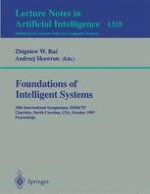1997 | ReviewPaper | Buchkapitel
Knowledge-based image retrieval with spatial and temporal constructs (Invited paper)
verfasst von : Wesley W. Chu, Alfonso F. Cárdenas, Ricky K. Taira
Erschienen in: Foundations of Intelligent Systems
Verlag: Springer Berlin Heidelberg
Enthalten in: Professional Book Archive
Aktivieren Sie unsere intelligente Suche, um passende Fachinhalte oder Patente zu finden.
Wählen Sie Textabschnitte aus um mit Künstlicher Intelligenz passenden Patente zu finden. powered by
Markieren Sie Textabschnitte, um KI-gestützt weitere passende Inhalte zu finden. powered by
A knowledge-based approach to retrieve medical images by feature and content with spatial and temporal constructs is developed. Selected objects of interest in a medical image (e.g. x-ray, MR image) are segmented, and contours are generated from these objects. Features (e.g. shape, size, texture) and content (e.g. spatial relationships among objects) are extracted and stored in a feature and content database. Knowledge about image features can be expressed as a hierarchical structure called a Type Abstraction Hierarchy (TAH). The high-level nodes in the TAH represent more general concepts than low-level nodes. Thus, traversing along TAH nodes allows approximate matching by feature and content if an exact match is not available. TAHs can be generated automatically by clustering algorithms based on feature values in the databases and hence are scalable to large collections of image features. Further, since TAHs are generated based on user classes and applications, they are context- and user-sensitive.A knowledge-based semantic image model is proposed which consists of four layers (raw data layer, feature and content layer, schema layer, and knowledge layer) to represent the various aspects of an image objects' characteristics. The model provides a mechanism for accessing and processing spatial, evolutionary, and temporal queries.A knowledge-based spatial temporal query language (KSTL) has developed which extends ODMG's OQL and supports approximate matching of feature and content, conceptual terms, and temporal logic predicates. Further a visual query language has been developed that accept pointclick-and-drag visual iconic input on the screen which is then translated into KSTL. User models are introduced to provide default parameter values for specifying query conditions.We have implemented a Knowledge-Based Medical Database System (KMeD) at UCLA, and currently under evaluation by the medical staff. The results from this research should be applicable to other multimedia information systems as well.
